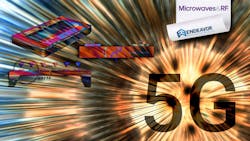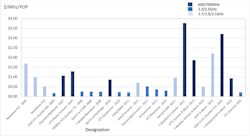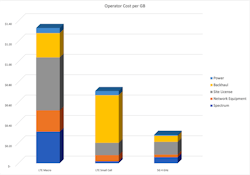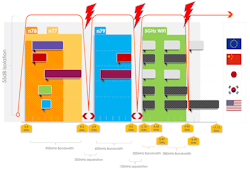Overcoming a Spectrum Deficit in a 5G World
This article appeared in Microwaves & RF and has been published here with permission.
Members can download this article in PDF format.
What you’ll learn:
- How increased demand for data services is causing a nationwide spectrum deficit.
- The importance of high-efficiency techniques in making the most of the available spectrum.
- Details on how RF filters, mMIMO, and unlicensed spectrum can help.
Radio-frequency spectrum is the lifeblood of the wireless industry. However, a deficit in the amount of spectrum available for growing mobile data services appears imminent.
In mid-January 2021, a big step was taken for 5G networks in the U.S. as mobile network operators (MNOs) spent over $80 billion to acquire the spectrum upon which their network services will be built. But according to a model of spectral demand created by Resonant, an updated version of a model developed by the FCC,1 increasing demand for data services threatens to result in a situation where data demand will overwhelm the available spectrum starting in 2021 and continue to worsen through 2025 (Fig. 1).
This analysis is based on 4G data services, though, and doesn’t even factor in the expanding 5G services that will require ever larger swaths of spectrum to fuel high-bandwidth applications. Given the amount of money spent on spectrum, ensuring that it’s not wasted is an important consideration. In our model, we estimate that more than $1 billion of spectrum in the U.S. alone could be wasted due to interference degrading spectral efficiency by as little as 1%.
Several techniques and technologies are available to better manage network capacity and improve on the problem by increasing spectral efficiency. Spectral efficiency is a measure of how effective the usable bandwidth, derived from a given frequency band, is consumed. Improving spectral efficiency is a function of the wireless protocol and several RF technologies, including the RF filter. This article explores how to boost spectral efficiency to help MNOs meet their need for spectrum.
The Importance of Spectrum
All wireless communication signals travel over the air via radio-frequency (RF) bands, or spectrum. The most tangible way to understand what spectrum is and how it works is to consider a car radio. When the radio is tuned to 95.5 FM, what’s happening is that the radio is picking up the signal from a station broadcasting at the 95.5-MHz frequency.
To listen to a different station requires re-tuning the radio to a different frequency, such as 99.9 FM. No two stations transmit over the same spectrum in the same geographic area, because it would create interference between the two. In addition, wireless signal strength is reduced as the radio gets further from the transmitter until, ultimately, the station can no longer be heard.
Mobile phones work in a similar way. Wireless operators license the right to transmit signals at certain frequencies and keep other operators or businesses from using those frequencies in a particular geographic area.
In the case of licensed frequency, the Federal Communications Commission (FCC) is the U.S. government agency that licenses and monitors who is using which slices of spectrum. Licenses are allocated in an auction process generating billions of dollars in revenue for the government.
The U.S. has led the world in allocation of commercial wireless spectrum prior to 5G but fell behind other countries in the allocation of “mid-band” spectrum (3 to 6 GHz). This has happened despite recognizing the significance of these frequencies for advancing new applications and an enhanced user experience, not to mention the generation of significant government revenue. China has taken a lead in allocating sub-6-GHz spectrum for 5G and aggressively deploying its network (Fig. 2).
However, FCC auction 105, which closed in July 2020 (the so-called Citizens Broadband Radio Service, or CBRS, Auction), made available the first sub-6-GHz spectrum (3550 to 3650 MHz) in the U.S. CBRS is RF spectrum from 3.5 to 3.7 GHz that the FCC repurposed from exclusive military use to allow for shared use of the spectrum for businesses and consumers. Certain stipulations are in place so that the spectrum can be shared with the U.S. military and other priority licensees such as local governments.
The auction generated $4.6 billion in licensing fees for the FCC. It was followed by Auction 107 (the so-called C-band auction) starting in December 2020 for licenses covering 280 MHz of spectrum in frequency bands below 4 GHz. That auction raised more than $80 billion, far surpassing even the most optimistic of estimates.
Considering the results from U.S. FCC Auction 105, which raised a total of $4.6 billion for 70 MHz of spectrum, spectrum is valued at more than $65 million per megahertz. Figure 3 breaks down this cost from previous auctions by dividing the cost per megahertz by the population density covered.
These extremely high costs mean that a 1% degradation in spectral efficiency caused by poor filtering and increased interference would waste bandwidth costing over $1 billion.
Predicting a Spectrum Deficit
Future spectrum requirements and trends can be understood as a function of current/past spectrum used for mobile broadband. Resonant developed a model (Fig. 4) predicting net spectrum availability based on the growth of global wireless data as forecast in the Cisco Annual Internet Report.2 This report predicts rapidly climbing wireless data consumption that will total 77 exabytes per month by 2022 (Fig. 5). The model is adjusted to account for projected additional network density via cell-site growth and improvements in technology resulting in increased spectral efficiency.
However, this represents a macro view of spectrum needs that vary significantly by location, network density, data speed, and time of day. In this model, we assume the same annual level of performance (data speed) is maintained, which is very conservative given that a fundamental premise of 5G is greater data speed. Nor does this demand consider the pull-forward in wireless data usage from “stay-at-home” changes in routine due to COVID-19.
Still, this model does clearly show the dramatic increase in spectrum needs driven by the growth in wireless data. mmWave spectrum will absolutely help in critical pinch points associated with dense urban environments, but the extreme coverage limitations at these high frequencies will limit widespread deployments.
Because network capacity varies by location and daily usage, making absolute numbers difficult, our model is based on relative changes to demand and capacity from a baseline year (2017), assuming the network is dimensioned for 30% surge capacity. All calculations (Fig. 4, again) are relative to this baseline year.
Data Growth
The critical equation that network operators balance both in the near and long term is the demand for network resources and services from consumers versus the available network capacity and the capital investment needed to meet customer requirements.
The model topline is the data growth as reported in the Cisco Annual Internet Report, and from that data we calculated the proportional data growth from the baseline year of 2017. From a demand perspective, the continual move to wireless for data applications, and in particular for video, is driving the increase in mobile data. And as new generations of wireless technology with more advanced devices are launched, increased use of broadband applications will follow—so long as the network can also support them.
Cell-Site Growth
The number of cell sites is a key factor in the overall network capacity. A traditional 4G macrocell has a transmission range up to 40 km and can support more than 200 users per sector, but this depends greatly on the terrain and the nature of the network service. The volume of data that can be processed at each cell site is determined by the spectral efficiency and total bandwidth processed (Fig. 6).
Spectral reuse can be improved by making the network denser by, for example, using small cells to allow the same spectrum to be utilized in progressively smaller areas. Ultimately there are diminishing capacity returns as interference between neighboring sites will increase as footprint decreases.
Spectral Efficiency
Network capacity relies on the spectral efficiency of wireless technologies, which, as expressed in the formula below, depends on new radio technologies:
With the inputs in Figure 4, we were able to determine the spectrum required for U.S. data services and compare that to the spectrum that’s expected to be available. From there, we can understand how and when a spectrum surplus turns to a spectrum deficit.
The model (Figure 1, again) shows that despite efforts to open new spectrum in the 3.5- to 4-GHz range, by 2025 the spectrum deficit relative to 2017 is more than 963 MHz.
Consequently, it becomes imperative for mobile operators to find other means to boost the total wireless data capacity. This involves increased capital spending to accelerate base-station and small-cell deployments, offloading data traffic to unlicensed spectrum, and utilizing technologies that boost spectral efficiency such as massive MIMO (mMIMO) and unlicensed 5G RF bands (5G NR-U), while at the same time improving RF filtering to protect from increasing potential for interference.
The Importance of Spectral Efficiency
One very clear aspect derived from the model is that with the significant cost of acquiring spectrum and the expected growth in data consumption, it’s critical that spectrum is used as efficiently as possible. A key reason is the cost of acquiring spectrum. As seen in Figure 7, the cost of acquiring licensed spectrum has risen dramatically in recent years.
Spectral efficiency is essential for mobile operators to make the most cost-effective use of their spectrum. Spectral efficiency defines how effective a given frequency carries a packet of data (bits per second per hertz) and depends on new radio technologies as defined by 3GPP and other standards bodies.
The technology innovations for improved spectral efficiency of 5G include better RF filters, mMIMO, and a more scalable frequency structure to optimize “packing” of signals into the available spectrum. These technologies improve spectral efficiency by enabling the processing of significantly wider bandwidths through the same infrastructure, reducing deployment costs to the MNO.
Spectral-Efficiency Technologies
RF Filters
As described above, critical to realizing the capacity and speed gains promised by 5G and enhanced mobile broadband (eMBB) services is to fully utilize all of the spectrum available to the wireless operator at maximum spectral efficiency. RF filters provide spectrum protection for the full frequency bandwidth from potential interfering signals. However, for 5G, filter requirements are quite different from 4G.
These new 5G filter requirements include:
- Wide bandwidth (>500 MHz and up to 2000 MHz)
- High frequency (>3 GHz)
- High power handling (to compensate for poor propagation at high frequency); it will be important for filters to accommodate very high power levels—more than 30 dBm (1 W) at the edge of the band
- Low loss (to maximize the signal efficiency)
And with increasing use of the 5G and Wi-Fi bands, filters will need to mitigate a very real interference problem that will degrade the user experience.
mMIMO
Massive MIMO is an antenna system with many antennas at a base station, from dozens up to 100 antennas. mMIMO offers improved coverage and capacity because multiple antennas can be combined to form multiple directed beams, enabling high data rates. The technology improves spectral efficiency by using space-division multiple access to simultaneously serve many users in a cell using the same bandwidth.
Licensed vs. Unlicensed Spectrum
While not exactly a spectrum-efficiency technology, unlicensed spectrum expands the spectrum available to MNOs. Currently, unlicensed spectrum is the foundation for several wireless local-area networks (LANs) and scientific and short-range consumer uses (Wi-Fi, Bluetooth, ultra-wideband, and so on). It has the advantage (Fig. 8) of being free for all to use but has limited range when compared to licensed technologies to minimize interference issues. The relative lack of regulation also means there are no guarantees for quality of service and security.
Mobile operators can offload data traffic from their licensed spectrum to unlicensed Wi-Fi networks (Fig. 9). Initially, operators were resistant to moving users onto Wi-Fi networks because of the negative revenue implications and relatively unmanaged frequency situation. However, the widespread availability of Wi-Fi functionality on smart devices, the potential for an overall improved quality of service, and the availability of streaming video to smartphones in dense environments drove customer retention.
5G New Radio – Unlicensed (5G NR-U) is one way in which mobile operators can utilize unlicensed spectrum. 3GPP Release 16 introduced 5G NR-U, which enables the implementation of 5G on unlicensed spectrum, opening access to significantly more spectrum both in the U.S. and other parts of the world. 5G NR-U can be deployed as a standalone configuration or “anchored” using licensed spectrum, where the lower-frequency “anchor” provides a coverage backstop, especially for essential overhead signaling.
Additional Spectrum Technology for 5G Deployments
In addition to the spectral-efficiency technologies, other techniques are available to help carriers bring services to users and manage their valuable spectrum assets:
Carrier aggregation
Because the total spectrum determines the user data speed, pieces of spectrum from different bands can be aggregated or combined to increase data speed (Fig. 10). This technique has been used extensively in 4G to increase data speeds, and expectations are that it will be used even more significantly for 5G, with over 10,000 carrier combinations predicted early in its rollout.
Dynamic spectrum sharing (DSS)
DSS is a transitional technology that doesn’t increase capacity. Rather, it addresses the issue of enabling 5G coverage using low-frequency spectrum that’s shared with 4G, accelerating early nationwide 5G deployment.
Traditionally, new-generation radio-access technologies are deployed on separate spectrum blocks, as was the case with 2G, 3G, and 4G. But doing so with 5G would require operators to buy new spectrum or re-farm existing spectrum to allocate the new generation. This is a very slow and costly process that could take a decade, but with DSS it can be done overnight. DSS allows for the deployment of both 4G and 5G in the same band and dynamically allocates spectrum resources between 4G and 5G based on user demand.
Time-division duplexing (TDD)
The use of TDD in 5G increases flexibility while also making spectrum usage more efficient. Unlike the alternative frequency-division duplexing (FDD) technology that utilizes entirely different frequencies for each channel, TDD employs the same frequency for communication in both directions (to and from the mobile device). By changing the time-slot duration, network performance can be tailored to meet different needs and use cases.
However, using the same frequencies has implications for interference management between neighboring sites. Thus, to utilize the spectrum most efficiently, TDD networks operating in the same frequency range must be synchronized. Base stations need to transmit at the same fixed time periods and all devices should only transmit in dedicated time periods.
High-frequency, wide-bandwidth filters
5G and Wi-Fi will have a coexistence challenge unlike any other in the history of wireless technology. 5G bands n77 and n79 and the 5-GHz and now 6-GHz Wi-Fi band are adjacent in frequency with little guard band to separate them. The coexistence problem has been summarized in a report by industry analyst firm Navian (Fig. 11):
“The 5-GHz band for Wi-Fi, which is essential for smartphones, sits between the 4.5-GHz and 6-7-GHz bands. If these frequencies are to be fully utilized, each bandwidth would need a steep filter. Also, with n77 and n79, high-performance filters for each of these bands would be needed at the same time, because a band gap of 200 MHz is too narrow to be fully utilized.”
Resonant XBAR RF Filter
RF filters designed for 4G requirements aren’t suited to these new filtering challenges, making a new filter design a necessity. Resonant’s XBAR filters provide the wide bandwidth, high-frequency operation, low loss, and high-power capability needed for 5G and Wi-Fi to coexist with maximum performance.
X-BAR, a bulk-acoustic-wave (BAW)-based resonator technology, can be used to create filters that deliver high performance in ultra-wideband applications for 5G networks. Other resonator technologies, initially developed for 4G, sacrifice performance to achieve the wide bandwidths, degrading spectral efficiency relative to XBAR.
XBAR resonators consist of a single-crystal, piezoelectric layer with a metal interdigital transducer (IDT) on the top surface. The metal traces excite a bulk acoustic wave within the piezoelectric, with the primary frequency and coupling characteristics determined by the physical dimensions and properties of the piezoelectric.
Summary
Just as the top three success factors in real estate are location, location, and location, success in wireless services hinges on spectrum, spectrum, and spectrum. Without the spectrum needed for wide bandwidth, a wireless carrier is at a significant disadvantage to its competitors. The importance of spectrum is evidenced by the $81 billion paid for spectrum during the FCC’s Auction 107.
But data demand is growing, which means the potential for a spectrum deficit is significant, perhaps growing to over 900 MHz by 2025 according to our model. This situation pressures operators to ensure they’re maximizing their complete spectrum holdings using technologies optimized for spectrum efficiency.
Maximizing spectral efficiency will take a new breed of RF filter that can minimize signal loss, mMIMO antennas that provide improved coverage, and access to unlicensed spectrum (via 5G NR-U) that can mitigate some of the growth in data consumption via unlicensed spectrum (Fig. 12). mMIMO and 5G NR-U will also increase the demand for wideband filters.
Resonant’s Infinite Synthesized Networks (ISN) filter design and XBAR technologies combine to create such filters for both FR1 and FR2. They have very wide bandwidths, support frequencies up to 40 GHz, manage high powers for these frequency bands, and offer very low loss.
References
1. “Mobile Broadband: The Benefits of Additional Spectrum, October 2010” FCC Staff Technical Paper.
2. https://www.cisco.com/c/en/us/solutions/executive-perspectives/annual-internet-report/index.html
About the Author
Mike Eddy
Senior Marketing Advisor, Resonant
Dr. Mike Eddy is vice president of corporate development for Resonant Inc. and has 30 years of experience in the wireless industry. Previously, he was president and founder of ANTONE Wireless, a leader in the 4G network infrastructure enhancement products that was acquired by Westell Technologies Inc. Before that, Dr. Eddy held several senior management positions at Superconductor Technologies Inc. He earned his Ph.D. in Solid State Chemistry from Oxford University and his MBA from Pepperdine University.














